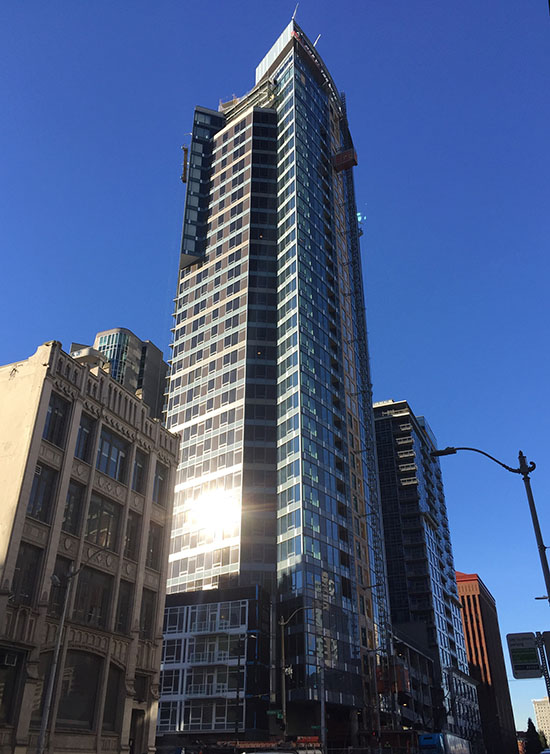|
Subscribe / Renew |
|
|
Contact Us |
|
| ► Subscribe to our Free Weekly Newsletter | |
| home | Welcome, sign in or click here to subscribe. | login |
Construction
| |
 |
May 9, 2017
Cast-in-place structures

Tower 12
Location: Seattle
Owner/developer: Continental Properties
Team: PCL Construction Services, general and concrete contractor; MG2, architect; Cary Kopczynski & Co., structural engineer; Cadman, ready-mix supplier
Tower 12, named after the Seattle Seahawks’ 12th Man, is a 34-story, 492,000-square-foot residential tower at Second Avenue and Virginia Street in downtown Seattle.
The building has 314 apartment units, 7,000 square feet of ground-level retail, four levels of parking above grade and five levels below. The project broke ground in early 2015 and was slated to finish in April.
Tower 12’s structural system has four main components: high-strength concrete and reinforcing bar, an innovative seismic core, performance-based seismic and wind design, and an optimized post-tensioned slab design.
Tower 12 utilized high-strength concrete and reinforcing bar to improve performance and constructability. A specified concrete compressive strength of 14,000 psi was used in columns up to the sixth level to reduce column sizes and improve the interior layout.
This synergistic use of high-strength concrete and rebar resulted in smaller columns and boundary elements, which enhanced interior design flexibility and increased the leasable floor area. It also allowed column sizes to be kept constant nearly full height, which maximized formwork productivity and helped maintain a rapid construction schedule.
The seismic system consisted of an innovative combination of coupled shear walls and ductile moment frames at the core, and included multiple link beams to effectively dissipate seismic energy. The unique core design enhanced seismic system ductility without the need for wall hinging. Seismic performance was improved without compromising constructability.
The structural engineer used a modified performance-based design with a nonlinear time history analysis to cycle the building’s seismic performance through a suite of input earthquake ground motions. The state-of-the-art core minimized the floor area required for wall structure and reduced the wall-reinforcing requirements, resulting in a more constructible system.
Due to the tower slenderness and shape, a wind tunnel test was performed to provide wind pressures for cladding design and to mitigate wind accelerations. The core stiffness and reinforcement were tuned to resist wind tunnel forces and provide acceptable levels of building acceleration.
Other Stories:
- Grand Award
Public works: Bridges - Special applications: Resiliency
- Community Award
- Concrete paving
- Pervious concrete
- Artistic and decorative concrete
- Residential concrete
- Public works: Renovations
- Public Works: Infrastructure
Sustainable Merit - Cast-in-place structures: Parking garage
Special applications: Technical merit (tie) - Tilt-up structures
- Special applications: Technical merit (tie)


